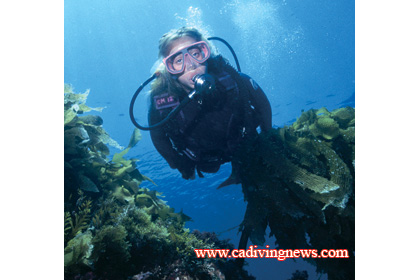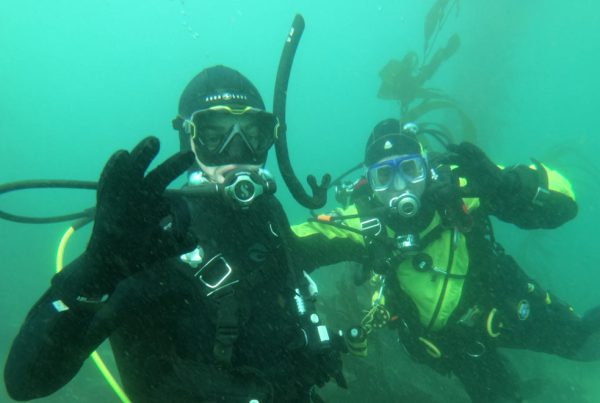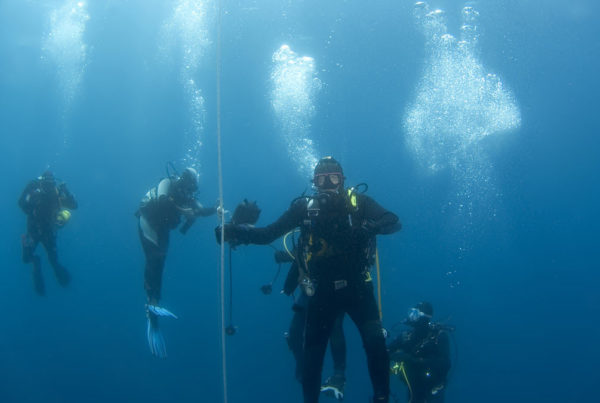Buoyancy control is one of the most difficult skills to master. This skill requires the coordinated use of many of the skills acquired in class and the confidence and comfort that come from experience. However, proper buoyancy control is not that difficult to achieve with a little understanding and practice.
Buoyancy is an upward force exerted on an object in a fluid that is equal to the weight of the fluid that the object displaces. The force of gravity counters buoyancy, and neutral buoyancy is achieved when the buoyant force balances the gravitational force. Each diver has a volume based on their size, type of thermal protection, and how they breathe. This volume displaces water and defines the buoyant force. This buoyant force is countered by the weight of the diver and gear, and is adjusted by adding lead. Enough lead should be used so the diver will float at eye level with a normal breath. Actually by this “diver” definition of neutral buoyancy, the diver is slightly positively buoyant since part of their head is supported out of the water.
There are rough formulas to approximate how much lead a diver needs, but our bodies and exposure suits are different and a diver should adjust how much lead they use on their first dive with new equipment, and revisit their need for lead regularly. Your need for lead will change as comfort and confidence builds, and your exposure suit ages. The trick is to add or subtract weight to achieve neutral buoyancy and then fine-tune your buoyancy throughout the dive using your BC and breathing. Lead should be positioned near the diver’s center of gravity. If more lead is positioned to one side or on the back, the unequal forces will tend the turn the diver to one side or face up. A diver cannot truly relax if he/she is constantly battling this tendency.
What many divers fail to realize is that, after proper weighting, the most important contributor to buoyancy is how they breathe. A diver can change his/her buoyancy by as much as eight pounds by breathing more or less deeply. A new diver will often take a deep breath prior to descending. This breath adds buoyancy and makes it all that more difficult to descend. Instead, strongly exhale and allow yourself to sink. You should not be weighted such that you sink rapidly, just enough such you drop beneath the surface so you can turn and swim to the bottom.
Divers can fine-tune their buoyancy by how deeply they breathe, and this is easier if they are relaxed and comfortable in the water. A new or uncomfortable diver will tend to keep their lungs fully inflated, and will require a lot of lead to skink them. More experienced divers retain a smaller, yet comfortable, volume of air in their lungs.
Try practicing buoyancy control in open water near a fixed object. An anchor line is perfect for this. With a comfortable breath and no hand sculling or fining, you should be able to remain stationary in the water. Inhale a little and you will rise, exhale a little and you will sink. If you cannot achieve neutrality comfortably by controlling your breathing add or remove air from your BC. Doing this next to a stationary object will easily provide you with an awareness of your movement in the water. Learn to develop an awareness of your movement in the water column. All divers should practice this skill until they can remain nearly motionless with no hand or fin motion. When you get really good you should be able to hang motionless for an extended period of time.
Use your breathing to adjust your buoyancy throughout your dive. If you want to go up a little to swim over a rock, simply inhale a bit more than you normally would. To sink on the other side exhale a bit. A comfortable breath on the other side should regain neutrality. Remember that your exposure suit will compress at depth and air should be added to your BC and/or dry suit to compensate when your buoyancy approaches the maximum range that you can comfortably control with your breathing.
Once you are comfortable in the water, then your breathing will be more relaxed and fluid and your buoyancy more controlled. Being relaxed will also allow you to become more aware of your surroundings. This awareness and control will not only make you a safer diver, but you will enjoy the dive that much more. Practical buoyancy control is all about having an awareness of your buoyancy and tuning your buoyancy by how deeply you breathe.









